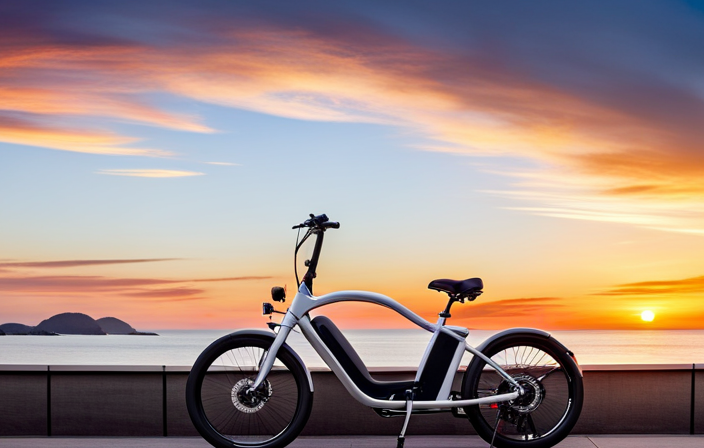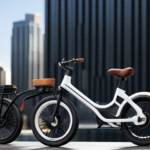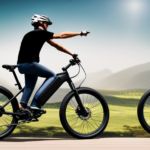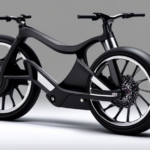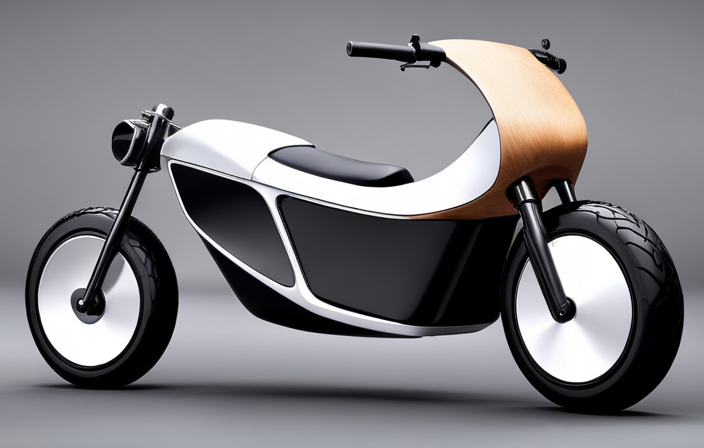As an avid electric bike enthusiast, I can confidently say that these two-wheeled wonders are like the Energizer Bunny—they just keep going and going.
In this article, I’ll delve into the fascinating world of electric bike longevity. From the different types of batteries to motor lifespan and frame durability, we’ll explore the factors that contribute to how long these eco-friendly rides last.
So buckle up, because we’re about to take a deep dive into the world of electric bikes and uncover their secrets to standing the test of time.
Key Takeaways
- Battery type and performance play a crucial role in the lifespan and overall efficiency of electric bikes.
- Regular maintenance of the battery, including proper charging and storage practices, can significantly extend its lifespan.
- The motor’s lifespan and performance can be maximized through regular maintenance, such as cleaning, lubricating, and monitoring its temperature.
- Checking and maintaining the frame and components of the electric bike enhance durability, longevity, and safety.
Types of Electric Bike Batteries
There are different types of electric bike batteries that determine how long they will last. Battery performance is a crucial factor in determining the overall efficiency and effectiveness of an electric bike.
The most common types of electric bike batteries include lithium-ion, nickel-metal hydride, and lead-acid batteries.
Lithium-ion batteries are widely used due to their high energy density, lightweight design, and longer lifespan compared to other types. They offer excellent battery performance and can be charged relatively quickly, reducing the charging time.
On the other hand, nickel-metal hydride batteries have a lower energy density and shorter lifespan compared to lithium-ion batteries.
Lead-acid batteries are the least expensive option but have a shorter lifespan and lower energy density.
Understanding the different types of electric bike batteries and their charging time is essential in selecting the right battery for optimal performance and longevity.
This knowledge will help us explore the subsequent section about battery life and range, delving deeper into the topic.
Battery Life and Range
To get the most out of your electric bicycle, make sure you’re aware of the battery life and range. Optimizing battery performance is essential for maximizing your riding experience. Proper battery maintenance can help you extend the lifespan and improve the overall efficiency of your electric bike. Here are some key tips to keep in mind:
| Battery Maintenance | Optimizing Battery Performance |
|---|---|
| Regularly check the battery charge level | Avoid overcharging or fully depleting the battery |
| Store the battery in a cool and dry place | Keep the battery away from extreme temperatures |
| Clean the battery terminals regularly | Avoid exposing the battery to water or moisture |
Charging and Maintenance Tips
Now let’s explore some tips for charging and maintaining your electric bicycle.
To ensure optimal performance and longevity of your electric bike, here are some essential charging tips and maintenance techniques:
-
Proper Charging: Always use the charger provided by the manufacturer and follow the recommended charging time and voltage. Overcharging or undercharging can affect battery life.
-
Storage Considerations: If you won’t be using your electric bike for an extended period, store it in a cool and dry place. Remember to charge the battery to around 50% before storing to prevent self-discharge.
-
Regular Maintenance: Keep your electric bike clean and free from dirt and debris. Check the tire pressure regularly, lubricate the chain, and inspect the brakes for wear. Also, schedule regular professional maintenance to detect any potential issues early on.
By following these charging tips and maintenance techniques, you can ensure the longevity and optimal performance of your electric bicycle.
Now, let’s delve into the topic of motor lifespan and performance, which plays a vital role in the overall functionality of your electric bike.
Motor Lifespan and Performance
Make sure you regularly maintain your electric bicycle’s motor to maximize its lifespan and optimize performance.
Motor maintenance is crucial for ensuring that your electric bike continues to run smoothly and efficiently. Several factors can affect the performance of your motor, including the level of maintenance it receives.
Regularly cleaning and lubricating the motor can prevent dirt and debris from affecting its performance. Additionally, checking the motor’s wiring and connections can help identify any potential issues before they become major problems. It is also important to monitor the motor’s temperature and ensure it does not overheat.
By taking these steps and regularly maintaining your electric bicycle’s motor, you can extend its lifespan and enjoy optimal performance.
With a well-maintained motor, you can now move on to ensuring the durability of your bike’s frame and components.
Frame and Component Durability
Regularly checking and maintaining your frame and components is essential for their durability and longevity. Here are three key reasons why component maintenance is crucial for electric bike riders:
-
Optimal Performance: Keeping your components well-maintained ensures that they function at their best, providing a smooth and efficient ride. This means regularly inspecting and lubricating moving parts, such as the chain, gears, and brakes, to minimize friction and maximize performance.
-
Safety First: A well-maintained bike is a safe bike. By regularly checking and tightening bolts, ensuring proper tire pressure, and inspecting brakes and cables for wear and tear, you can prevent accidents and ensure a secure ride every time.
-
Riding Style Matters: Your riding style can have a significant impact on the wear and tear of your bike’s components. Frequent hard stops and aggressive acceleration can put more stress on the brakes and drivetrain, leading to faster wear. By adjusting your riding style to be smoother and more controlled, you can extend the lifespan of your components.
By properly maintaining your frame and components, you can enhance their durability and enjoy your electric bike for years to come.
Now, let’s dive into the next section about riding conditions and terrain, which also play a vital role in the longevity of your electric bike.
Riding Conditions and Terrain
To ensure a smooth and enjoyable ride, consider the riding conditions and terrain you encounter most frequently. Your riding techniques and the type of terrain you ride on can have a significant impact on the battery life of your electric bike.
When riding on hilly or uneven terrain, it’s important to use the appropriate riding technique to optimize battery efficiency. For example, using a lower assist level on steep inclines can help conserve battery power. Additionally, being mindful of your acceleration and maintaining a steady speed can also help extend your battery life.
By adapting your riding techniques to the specific terrain and conditions you encounter, you can maximize the longevity of your electric bike’s battery. Taking these factors into consideration will help you make the most of your electric bike while minimizing the impact on battery life.
When it comes to warranty and after-sales support, it is important to choose a reputable manufacturer or retailer that offers a comprehensive warranty.
Warranty and After-Sales Support
Now that we’ve covered the impact of riding conditions and terrain on the longevity of electric bikes, let’s delve into the topic of warranty and after-sales support.
As with any complex machinery, electric bikes may encounter issues that require troubleshooting or repair. Understanding the warranty and after-sales support offered by manufacturers is crucial in ensuring a smooth ownership experience.
Here are some common warranty issues you may come across:
- Battery performance degradation over time
- Motor malfunctions or failures
- Electrical system glitches
- Frame or component defects
Dealing with these problems can be frustrating, but having a comprehensive warranty and a responsive customer support team can make all the difference. It’s important to familiarize yourself with the warranty terms and conditions, including coverage duration and any exclusions. This will help you navigate any potential issues that may arise during your ownership.
Now, let’s explore the exciting world of upgrading and customizing your e-bike.
Upgrading and Customizing Your E-bike
When it comes to upgrading my e-bike, there are several benefits and considerations to keep in mind.
Upgrading can improve performance, extend range, and enhance the overall riding experience. However, it’s important to carefully consider the compatibility of the upgrades with the existing components and the potential impact on the e-bike’s lifespan.
Customization options for e-bikes are vast, ranging from upgrading the battery and motor to adding accessories like racks, lights, and fenders. These customization options allow riders to tailor their e-bike to their specific needs and preferences. However, it’s crucial to ensure that the chosen upgrades are compatible and won’t compromise the integrity or functionality of the e-bike.
Benefits and Considerations of Upgrading
One thing to consider before upgrading your electric bike is how it will benefit your overall riding experience.
Upgrading your e-bike can bring about significant improvements in performance and functionality. However, it is important to weigh the costs of upgrading against the potential benefits.
Upgrading costs can vary depending on the specific components or features you wish to enhance. It is crucial to research and compare prices to ensure you are making a cost-effective decision.
Performance improvements can include increased speed, better handling, and improved battery life. These upgrades can enhance your overall riding experience, making your electric bike more enjoyable and efficient.
Considering the benefits and costs of upgrading will help you make an informed decision that aligns with your needs and preferences.
Now, let’s explore the various customization options for e-bikes.
Customization Options for E-bikes
Let’s take a look at the different ways you can customize your e-bike. As e-bikes become more popular, the demand for customization options has grown. Riders want to personalize their electric bikes to suit their style and preferences. From color schemes to accessories, there are several customization options available to make your e-bike truly unique. Here is a breakdown of some popular customization options and design trends:
| Customization Option | Description | Design Trend |
|---|---|---|
| Paint and Graphics | Custom paint jobs and decals can give your e-bike a personalized look. | Matte finishes and geometric patterns are currently trending. |
| Accessories | Add-ons like fenders, racks, and lights can enhance functionality and style. | Minimalistic and sleek accessories are popular choices. |
| Upholstery | Choosing a custom seat cover can add comfort and style to your e-bike. | Vegan leather and perforated designs are in vogue. |
Impact of Upgrades on E-bike Lifespan
Choosing to customize your e-bike with upgrades can have a significant impact on its overall lifespan. Upgrading the battery and motor can greatly enhance the performance and longevity of your electric bike. Here are three ways these upgrades can make a difference:
-
Impact of battery upgrades: By upgrading to a higher capacity battery, you can enjoy longer rides without worrying about running out of power. This will extend the overall lifespan of your e-bike as you won’t be constantly draining the battery to its limits.
-
Effect of motor upgrades: Upgrading to a more powerful motor can improve the bike’s acceleration and climbing abilities. This means less strain on the motor, resulting in reduced wear and tear over time.
-
Improved overall efficiency: Upgrading both the battery and motor can enhance the overall efficiency of your e-bike, allowing it to run smoother and more efficiently. This not only increases its lifespan but also provides a more enjoyable riding experience.
With these upgrades, your e-bike can last longer and perform better.
Now let’s explore the environmental impact of e-bikes.
Environmental Impact of E-bikes
The environmental impact of e-bikes is a key consideration when deciding whether or not to invest in one. E-bikes have the potential to greatly impact public transportation, as they provide an alternative mode of transportation that is both efficient and environmentally friendly. With the increasing popularity of e-bikes, cities are starting to invest in e-bike infrastructure, such as dedicated bike lanes and charging stations. This not only promotes accessibility for e-bike users but also encourages more people to choose e-bikes over cars, reducing traffic congestion and emissions.
Additionally, e-bikes have a lower carbon footprint compared to traditional vehicles, as they consume less energy and emit fewer greenhouse gases. Considering the positive impact on public transportation and the environment, investing in an e-bike seems like a wise choice.
Moving on to e-bike safety and regulations…
E-bike Safety and Regulations
When it comes to riding an e-bike, safety should always be a top priority.
In order to ensure a safe and enjoyable ride, it is important to have the right safety gear, such as a helmet, reflective clothing, and lights.
Additionally, familiarizing oneself with local laws and regulations regarding e-bike use is crucial to avoid any legal issues or accidents on the road.
E-bike Safety Gear and Practices
Make sure you always wear your safety gear when riding an e-bike to ensure your protection. The most important piece of safety gear for e-bike riders is a helmet. When choosing a helmet for e-bike use, it is recommended to opt for a full-face helmet that provides maximum coverage and protection.
Additionally, consider helmets that are specifically designed for e-bike riders, as they offer additional features like reinforced chin guards and increased impact resistance.
Another important aspect of e-bike safety is taking a safety course. These courses provide valuable information on e-bike handling, traffic rules, and emergency maneuvers. They help riders develop the necessary skills to ride safely and confidently.
By wearing proper safety gear and taking safety courses, e-bike riders can significantly reduce the risk of accidents and injuries.
Now let’s delve into the local laws and regulations for e-bike use in your area.
Local Laws and Regulations for E-bike Use
To ensure compliance with local laws, find out the specific regulations governing e-bike use in your area. Electric bike rental services and e-bike sharing programs have become increasingly popular, providing convenient transportation options in many cities. However, it is crucial to understand and abide by the local laws and regulations to ensure a safe and legal riding experience. Different regions may have varying rules regarding e-bike usage, including speed limits, designated bike lanes, and helmet requirements. To help you navigate these regulations, here is a table outlining some example regulations in different areas:
| Location | Speed Limit (mph) | Designated Bike Lanes | Helmet Requirement | Additional Regulations |
|---|---|---|---|---|
| City A | 20 | Yes | Yes | No riding on sidewalks |
| City B | 15 | Yes | No | Electric bikes only allowed on certain roads |
| City C | 25 | No | Yes | No restrictions |
Understanding and following these regulations is essential to ensure the safe and legal operation of e-bikes in your area. It is also important to note that these regulations may change, so it is always a good idea to stay updated on any new laws or ordinances.
Now let’s delve into the fascinating world of e-bike lifespan case studies.
E-bike Lifespan Case Studies
E-bike lifespan case studies show that regular maintenance can significantly extend their longevity. Taking care of your e-bike is crucial for maximizing its lifespan. Here are some factors that can affect the lifespan of an e-bike:
-
E-bike battery longevity:
-
Proper charging and discharging cycles
-
Avoiding extreme temperature conditions
-
Regularly checking and maintaining battery health
-
Factors affecting e-bike lifespan:
-
Riding conditions and terrain
-
Frequency of use
-
Quality of components and materials
By following proper maintenance practices and considering these factors, you can ensure that your e-bike lasts for many years.
Now, let’s move on to some frequently asked questions about e-bike lifespan and maintenance.
E-bike Lifespan FAQs
Understanding the factors that can impact the lifespan of your e-bike is important for making informed decisions about maintenance and care. One crucial aspect of e-bike maintenance is following a regular maintenance schedule.
This involves routine inspections of the battery, motor, brakes, and tires, as well as lubricating the chain and checking the electrical connections. Adhering to a maintenance schedule helps identify any potential issues early on and prevents them from escalating into more significant problems.
Additionally, several factors can affect the lifespan of your e-bike, such as the quality of the components, the frequency of use, the terrain it is ridden on, and the weight it carries. By understanding these factors and properly maintaining your e-bike, you can ensure it lasts longer and performs optimally.
Now, let’s move on to the e-bike maintenance checklist.
E-bike Maintenance Checklist
Make sure you regularly inspect the battery, motor, brakes, tires, and electrical connections, as well as lubricate the chain and check for any potential issues. Following an e-bike maintenance schedule is crucial to ensure optimal performance and longevity of your electric bike. By performing routine checks and addressing any problems promptly, you can avoid costly repairs and breakdowns. Here is a helpful e-bike maintenance checklist:
| Maintenance Task | Frequency |
|---|---|
| Battery inspection | Monthly |
| Motor check | Every 3 months |
| Brake adjustment | Every 6 months |
| Tire inspection | Monthly |
| Electrical connection | Every 3 months |
Troubleshooting common e-bike issues requires a systematic approach. By identifying the symptoms, such as loss of power or unusual noises, you can determine the root cause and take appropriate action. Regular maintenance and prompt troubleshooting will help keep your e-bike in optimal condition, ensuring a longer lifespan. Now, let’s move on to some valuable tips for extending your e-bike’s lifespan.
Tips for Extending E-bike Lifespan
When it comes to maximizing the lifespan of your e-bike, there are several key factors to consider.
First and foremost, it is crucial to store your e-bike properly, ensuring that it is protected from the elements and stored in a secure location.
Additionally, regular cleaning and lubrication of the bike’s components is essential for optimal performance and longevity.
Best Practices for E-bike Storage
To ensure your e-bike lasts for a long time, it’s important to follow best practices for storage. Properly storing your e-bike can help preserve its performance and protect its components, especially the batteries.
Here are some e-bike storage solutions and tips to keep in mind:
- Store your e-bike in a cool and dry place to prevent moisture damage.
- Keep your e-bike away from direct sunlight and extreme temperatures.
- If possible, remove the battery and store it separately in a cool location.
- Use a bike cover or a storage bag to protect your e-bike from dust and scratches.
By implementing these storage practices, you can ensure that your e-bike remains in optimal condition and its batteries stay protected.
Now, let’s move on to cleaning and lubrication tips to further maintain your e-bike’s longevity.
Cleaning and Lubrication Tips
Maintaining a clean and well-lubricated e-bike is essential for optimal performance and longevity. When it comes to cleaning techniques, it’s important to start with a gentle approach.
Use a bucket of warm water mixed with a mild detergent to wipe down the frame, handlebars, and other components. Avoid using high-pressure water or harsh chemicals, as these can damage the electrical components.
Pay special attention to the drivetrain, which collects dirt and grime easily. Use a degreaser and a brush to thoroughly clean the chain, cassette, and derailleur.
Once the bike is clean, it’s time to focus on lubrication methods. Apply a high-quality lubricant specifically designed for bicycles to the chain, derailleurs, and pivot points. This will ensure smooth operation and protect against corrosion.
Regularly cleaning and lubricating your e-bike will not only improve its performance but also extend its lifespan. By following these maintenance practices, you can avoid common mistakes that reduce e-bike lifespan.
Avoiding Common Mistakes That Reduce E-bike Lifespan
Make sure you avoid common mistakes that can reduce the lifespan of your e-bike. Proper maintenance is essential for maximizing battery life and ensuring the longevity of your electric bike.
One common mistake is failing to regularly check tire pressure. Underinflated tires can lead to increased rolling resistance and excessive wear on the motor.
Another mistake to avoid is neglecting to clean and lubricate the bike’s chain and drivetrain. A dirty and dry chain can cause friction, reducing efficiency and putting strain on the motor.
Additionally, it is important to store your e-bike in a cool and dry place, away from extreme temperatures and moisture.
By avoiding these common mistakes and following proper maintenance procedures, you can extend the lifespan of your e-bike and enjoy many years of reliable performance.
Now, let’s move on to the conclusion and final thoughts.
Conclusion and Final Thoughts
In conclusion, it’s clear that electric bikes are a reliable and sustainable mode of transportation. When considering the upgrading options for electric bikes, it’s essential to choose components that are compatible with the bike’s electrical system.
Upgrading the battery can significantly improve the bike’s range and performance, while upgrading the motor can enhance its power output. Additionally, upgrading the brakes and suspension can improve the overall safety and comfort of the ride. It’s important to note that these upgrades should be done with caution and by following the manufacturer’s guidelines to prevent any damage to the bike.
As for the environmental impact, electric bikes produce zero emissions, making them an eco-friendly alternative to traditional modes of transportation. By choosing to ride an electric bike, we can reduce our carbon footprint and contribute to a cleaner and healthier environment.
Frequently Asked Questions
Are there any specific regulations or laws regarding the use of electric bikes?
There are specific regulations and laws regarding the use of electric bikes. These regulations focus on electric bike safety and include speed limits, helmet requirements, and restrictions on where electric bikes can be ridden. Additionally, electric bike sharing programs offer numerous benefits such as reducing traffic congestion and promoting sustainable transportation.
What are some common issues that can occur with electric bike batteries?
Common battery problems with electric bikes include decreased range, slow charging, and reduced battery life. Troubleshooting can involve checking connections, ensuring proper charging techniques, and considering factors like temperature and usage patterns.
Can I upgrade or customize my electric bike to improve its performance?
Yes, you can upgrade and customize your electric bike to improve its performance. There are various upgrading options available, such as installing a more powerful motor, upgrading the battery, or adding performance enhancements like suspension upgrades or larger tires. These modifications can greatly enhance your electric bike’s performance.
How can I extend the lifespan of my electric bike?
To increase the lifespan of an electric bike, proper maintenance is crucial. Regularly clean and lubricate the chain, keep the battery charged between 20-80%, and store it in a cool, dry place. Following these maintenance tips will help your electric bike last longer.
What are some environmental benefits of using an electric bike compared to a traditional bicycle or car?
Compared to traditional bicycles or cars, electric bikes offer numerous environmental benefits. They have reduced carbon emissions, helping combat climate change, and also provide health benefits by promoting physical activity and reducing air pollution.
Conclusion
In conclusion, electric bikes can provide years of reliable and enjoyable transportation if properly cared for. By choosing the right type of battery, maintaining it regularly, and following charging and maintenance tips, you can ensure a long lifespan for your e-bike.
Additionally, the motor and frame durability are important factors to consider when purchasing an electric bike. Remember, a stitch in time saves nine, so take care of your e-bike to avoid costly repairs down the road.
With proper care and attention, your e-bike will be your trusty companion for many miles to come.
